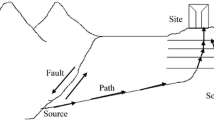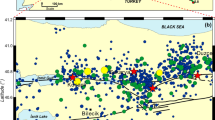Abstract
The local site has a significant impact on the scale of destruction during an earthquake. Past large historical earthquakes in Nepal have always resulted in substantial damages in Bhaktapur city mainly due to the local soil amplification effect. Bhaktapur is one of the historically enriched cities of the Kathmandu Valley, giving the name of the living Museum. To assess the conservation and preservation of historic structures, seismic demand of the particular sites is required. In this study, the one-dimensional site response analysis of Bhaktapur city is carried out using the equivalent linear and non-linear analysis methods. Eleven deep boreholes that lie in the historically important locations of Bhaktapur city were selected. The dynamic properties of the soil layers were assigned in reference to the past research works. A suite of input earthquake ground motions matching the target response spectrum was considered in this study. The predominant period obtained from the numerical analysis was compared with the predominant period obtained from the microtremor test for the reliability check of numerical analysis. The amplification factor obtained from equivalent linear analysis varies from 0.9 to 1.5 whereas, for non-linear analysis, it ranged from 0.80 to 1.30. The predominant period obtained from equivalent linear ranged from 0.3 to 0.6 s and, for non-linear analysis, it ranged from 0.15 to 0.4 s. The shaking maps show that the far-west and east-south parts are seismically more vulnerable. The results were further compared with the damage scenario observed during the 2015 Gorkha earthquake.


















Similar content being viewed by others
References
Atik LA, Abrahamson N (2010) An Improved method for non-stationary spectral matching. Earthq Spectra 26:601–617
BDC (2011) Resource mapping report: Bhaktapur district, Nepal. District Information and Documentation Centre (DIDC), Bhaktapur Development Committee (BDC)
Behrou R, Haghpanah F, Foroughi H (2017) Seismic site effect analysis for the city of Tehran using equivalent linear ground response analysis. Int J Geotech Eng. https://doi.org/10.1080/19386362.2017.1395998
Bolisetti C, Whittaker AS, Masonb HB, Almufti I, Willford M (2014) Equivalent linear and nonlinear site response analysis for design and risk assessment of safety-related nuclear structures. Nucl Eng Des 275(2014):107–121. https://doi.org/10.1016/l.nucengdes.2014.04.033
Chapagain SK, Pandey VP, Shrestha S, Nakamura T, Kazama F (2010) Assessment of deep groundwater quality in Kathmandu Valley using multivariate statistical techniques. J Water Air Soil Pollut 210(1):277–288
Delgado J, Casado CL, Giner J, Estevez A, Cuenca A, Molina S (2000) Microtremors as a geophysical exploration tool: applications and limitations. Pure Appl Geophys 157:1445–1462
Department of Mines and Geology (DMG) (1998) Engineering and environmental geology map of Kathmandu Valley. Department of Mines and Geology, Kathmandu, Nepal
El-Emam M, Khan Z, Abdalla J, Irfan M (2015) Local site effects on seismic ground response of major cities in UAE. Nat Hazards. https://doi.org/10.1007/s11069-015-1873-9T
Field EH, Jacob KH (1993) The theoretical response of sedimentary layers to ambient seismic noise. Geophys Res Lett 20(24):2925–2928
Fujii R, Sakai H (2001) Palynological study on the drilled sediments from the Kathmandu Basin and its paleoclimatic significances. J Nepal Geol Soc 25:53–61
Golder Associates (Canada) BECA World International (New Zealand) in association with SILT Consultants (P.) Ltd. (Nepal), TAEC Consult (P.) Ltd. (Nepal) and Urban Regional Research (USA) (1993) Seismic Hazard Mapping and Risk Assessment for Nepal. BECA (1994).
Groholski DR, Hashash YMA, Kim B, Musgrove M, Harmon J, Stewart JP (2016) Simplified model for small-strain nonlinearity and strength in 1D seismic site response analysis. J Geotech Geo-environ Eng 142(9)
Hamilton EL (1976) Shear wave velocity versus depth in marine sediments: a review. Geophysics 41(5):985–996
Hashash YMA, Phillips C, Groholski DR (2010) Recent Advance in Non-linear Site Response analysis. In: Fifth International Conference on Recent Advances in Geotechnical Earthquake Engineering and Soil Dynamics and Symposium in Honor of Professor I.M. Idriss, San Diego, Colifornia
Hashash YMA, Groholski DR, Phillips CA, Park D, Musgrove M (2016) DEEPSOIL 6.1, User Manual. University of Illionois, Urbana-champaign
Japanese International Cooperation Agency (JICA) (1990) Groundwater management project in the Kathmandu Valley. Final report to Nepal water supply cooperation.
Japanese International Cooperation Agency (JICA) (2002) The study on earthquake disaster mitigation in the Kathmandu Valley, Kingdom of Nepal. final report, volume III
Jinan Z (1987) Correlation between seismic wave velocity and the number of blows of SPT and depth. ASCE, Selected Papers from the Chinese J. Geotech. Eng., pp 92–100
Karki P, Maskey PN (2010) Estimation of site-specific seismic design parameters, Lalitpur, Nepal. Dissertation, Institute of Engineering, Tribhuvan University
Kramer SL (1996) Geotechnical earthquake engineering. Prentice Hall, Delhi
Lamichhane S, Luke B (2016) Input ground motions for earthquake site response analyses: deep sediment column with cementation. Int J Geotech Eng 10(2):190–204. https://doi.org/10.1080/19386362.2015.1113354
Mahmood k, Khan SA, Iqbal Q, Karim F, Iqbal S (2020) Equivalent linear and nonlinear site-specific ground response analysis of Pashto Cultural Museum Peshawar, Pakistan. Iran J Sci Technol Trans Civil Eng. https://doi.org/10.1007/s40996-020-00346-4
Maskey PN, Datta TK (2005) Seismic risk of monumental structures of Kathmandu Valley. In: Lourenco, Roca (eds) Structural analysis of historical constructions-Modena. Taylor and Francis Group, London, pp 1103–1109
Meng F (2003) Dynamic Properties of Sandy and Gravelly Soils. Architectural and Environmental Engineering, The University of Texas, Austin, Texas, Department of Civil
MoHA (2015) Ministry of Home Affairs, Incident Report of Earthquake. http://drrportal.gov.np
Moribayashi S, Maruo Y (1980) Basement topography of the Kathmandu Valley Nepal—an application of the gravitational method to the survey of a tectonic basin in the Himalaya. Journal of Japan Society of Engineering Geology 21:30–37
Nakamura Y(1989) A method for dynamic characteristics estimation of subsurface using microtremor on the ground surface. Quarterly Report of Railway Technical Research Institute (RTRI), 30 (1)
Nogoshi M, Igarashi T (1970) On the propagation characteristics of microtremors. J Atmos Oceanic Technol 23:264–280
Nogoshi M, Igarashi T (1971) On the amplitude characteristics of microtremors. J Atmos Oceanic Technol 24:24–40
Ohta Y, Goto N (1978) Empirical shear wave velocity equations in terms of characteristic soil indexes. Earthquake Eng Struct Dynam 6:167–187
Pagliaroli A, Aprile V, Chamlagain D, Lanzo G, Poovarodom N (2018) Assessment of site effects in the Kathmandu valley, Nepal, during the 2015 Mw 7.8 Gorkha earthquake sequence using 1D and 2D numerical modelling. Engineering geology. https://doi.org/10.1016/j.enggeo.2018.03.011
Pandey MR (2000) Ground response of Kathmandu Valley on the basis of microtremors. In: Proceedings of the 12th World Conference on Earthquake Engineering, Auckland, New Zealand, paper no. 2106
Paudayal KN (2015) New discovery of late pleistocene vertebrate fossils from the Thimi formation, Bhaktapur. Nepal J Inst Sci Technol Tribhuvan Univ 20(2):73–75
Paudyal YP, Yatebe R, Bhandary NP, Dahal RK (2012) A study of local amplification effect of soil layers on ground motion in the Kathmandu Valley using microtremor analysis. Earthq Eng Eng Vib 11:257–268
Rathje EM, Kottke AR, Trent WL (2010) Influence of input motion and site property variabilities on seismic site response analysis. J Geotech Geo-Environ Eng 136(4):607–619
Satyam ND, Towhata I (2016) Site-specific ground response analysis and liquefaction assessment of Vijayawada city (India). Natural Hazard. https://doi.org/10.1007/s11069-016-2166-7
Seed RB, Harder Jr, LF (1990) SPT-based analysis of cyclic pore pressure generation and undrained residual strength. In: Proceeding, H. Bolton Seed Memorial Symp., Univ. of California, Berkeley. J.M. Duncan (Ed.), Bi-Tech Publishers, Vancouver, Canada, Vol.2, May 9–11, pp 351–376
Seed HB, Idriss IM (1970) Soil moduli and damping factors for dynamic response analyses. Earthquake Engineering Research Center, Report No. EERC 70–10, University of California, Berkeley, California
SESAME (2004) Guideline for the implementation of the H/V spectral ratio technique on ambient vibrations: Measurements, processing and interpretation. European Commission-Research General Directorate
Shakya M, Duwal S, Kawan CK (2016) Rapid Visual Damage Assessment of Masonry Buildings after 2015 Gorkha Earthquake: A Case Study of Bhaktapur Municipality. Internation Conference on Earthquake Engineering and Post Disaster Reconstruction Planning, 24–26April, Nepal
Shrestha O, Koirala A, Hanisch J, Busch K, Kerntke M, Jager S (1999) A geoenvironmental map for the sustainable development of the Kathmandu Valley. Nepal Geojournal 49:165–172. https://doi.org/10.1023/a:1007076813975
Stanko D, Markusic S, Gazdek M, Sankovic V, Slukan I, Ivancic I (2019) Assessment of the seismic site amplification in the city of Ivanec (NW Part of Croatia) using the Microtremor HVSR method and equivalent-linear site response analysis. Geosciences. https://doi.org/10.3390/geosciences9070312
Stone YC, Yokel FY, Celebi M, Hanks T, Leyendecker EV (1987) Engineering aspects of the September 19, 1985, Mexico earthquake. NBS Building Science Series 165, National Bureau of Standards, Washington, D.C
Thakur JK, Diwakar J, Singh SK (2015) Hydrogeochemical evaluation of groundwater of Bhaktapur Municipality, Nepal. Environ Earth Sci. https://doi.org/10.1007/s12665-015-4514-4
Vucetic M, Dobry R (1991) Effect of soil plasticity on a cyclic response. J Geotech Eng ASCE117 (1):89–107
Youngs RR, Chio SJ, Silva WJ, Humphrey JR (1997) Strong ground motion attenuation relationships for subduction zone earthquakes. Seismol Res Lett 68 (1)
Acknowledgements
The authors would like to express sincere thanks to Professor Dr. Netra Prakash Bhandary, Graduate School of Science and Engineering, Ehime University, Japan, for providing us with the microtremor instrument.
Author information
Authors and Affiliations
Corresponding author
Rights and permissions
About this article
Cite this article
Kawan, C.K., Maskey, P.N. & Motra, G.B. A Study of Local Soil Effect on the Earthquake Ground Motion in Bhaktapur City, Nepal Using Equivalent Linear and Non-linear Analysis. Iran J Sci Technol Trans Civ Eng 46, 4481–4498 (2022). https://doi.org/10.1007/s40996-022-00858-1
Received:
Accepted:
Published:
Issue Date:
DOI: https://doi.org/10.1007/s40996-022-00858-1




